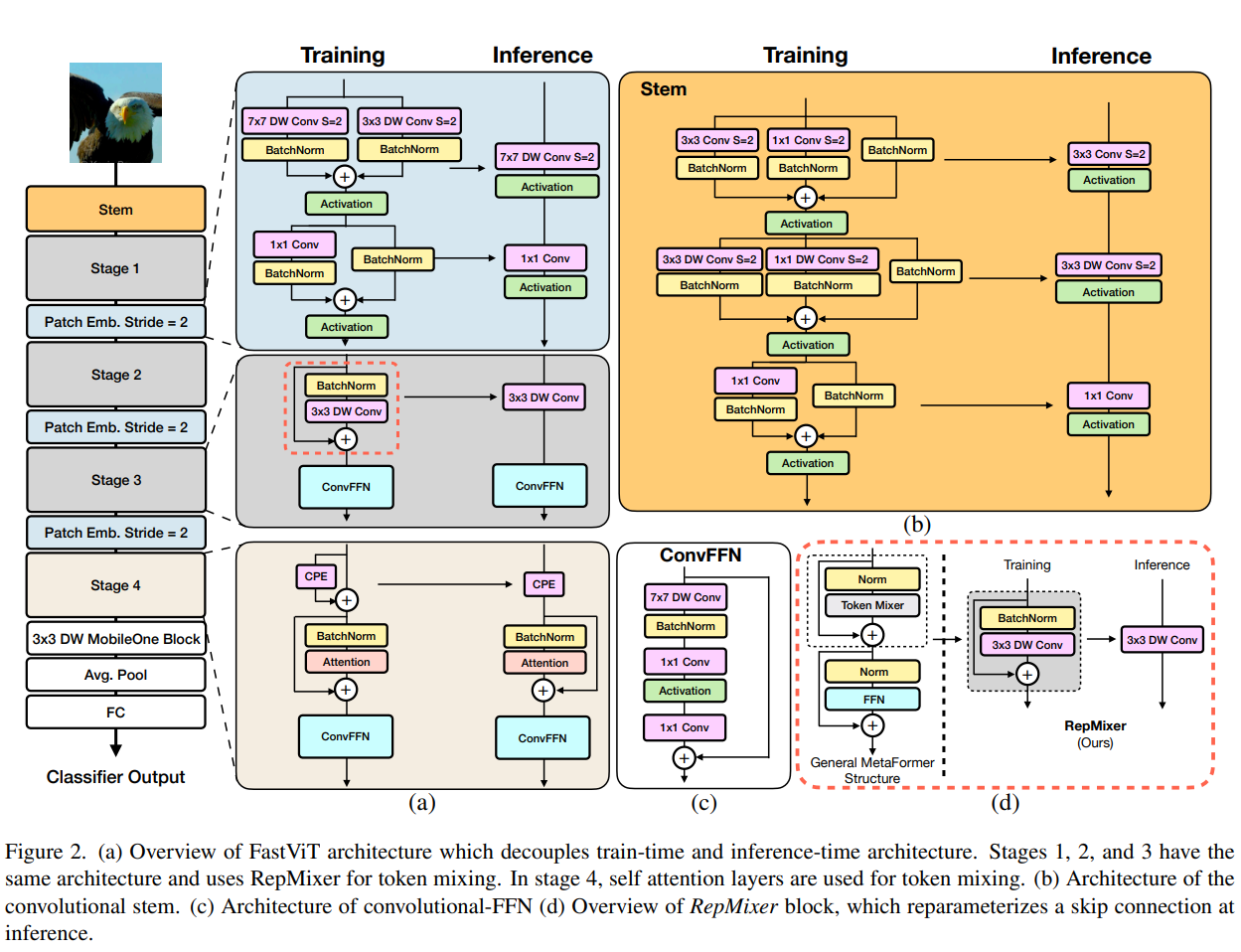文章目录
- 摘要
- 安装包
- 安装timm
- 安装 grad-cam
- 安装mmcv
- 数据增强Cutout和Mixup
- EMA
- 项目结构
- 计算mean和std
- 生成数据集
- 补充一个知识点:torch.jit
- 两种保存方式
摘要
论文翻译:https://wanghao.blog.csdn.net/article/details/132407722?spm=1001.2014.3001.5502
或者
https://blog.csdn.net/m0_47867638/article/details/132441806?spm=1001.2014.3001.5502
官方源码:https://github.com/apple/ml-fastvit
FastViT是一种混合ViT架构,它通过引入一种新型的token混合运算符RepMixer来达到最先进的延迟-准确性权衡。RepMixer通过消除网络中的跳过连接来降低内存访问成本。FastViT进一步应用训练时间过度参数化和大核卷积来提高准确性,并根据经验表明这些选择对延迟的影响最小。实验结果表明,FastViT在移动设备上的速度比最近的混合Transformer架构CMT快3.5倍,比EfficientNet快4.9倍,比ConvNeXt快1.9倍。在相似的延迟下,FastViT在ImageNet上的Top-1精度比MobileOne高出4.2%。此外,FastViT模型能够较好的适应域外和破损数据,相较于其它SOTA架构具备很强的鲁棒性和泛化性能。

这篇文章使用FastViT完成植物分类任务,模型采用fastvit_t8向大家展示如何使用FastViT。fastvit_t8在这个数据集上实现了95+%的ACC,如下图:


通过这篇文章能让你学到:
- 如何使用数据增强,包括transforms的增强、CutOut、MixUp、CutMix等增强手段?
- 如何实现FastViT模型实现训练?
- 如何使用pytorch自带混合精度?
- 如何使用梯度裁剪防止梯度爆炸?
- 如何使用DP多显卡训练?
- 如何绘制loss和acc曲线?
- 如何生成val的测评报告?
- 如何编写测试脚本测试测试集?
- 如何使用余弦退火策略调整学习率?
- 如何使用AverageMeter类统计ACC和loss等自定义变量?
- 如何理解和统计ACC1和ACC5?
- 如何使用EMA?
如果基础薄弱,对上面的这些功能难以理解可以看我的专栏:经典主干网络精讲与实战
这个专栏,从零开始时,一步一步的讲解这些,让大家更容易接受。
安装包
安装timm
使用pip就行,命令:
pip install timm
mixup增强和EMA用到了timm
安装 grad-cam
pip install grad-cam
安装mmcv
pip install -U openmim
mim install mmcv
数据增强Cutout和Mixup
为了提高成绩我在代码中加入Cutout和Mixup这两种增强方式。实现这两种增强需要安装torchtoolbox。安装命令:
pip install torchtoolbox
Cutout实现,在transforms中。
from torchtoolbox.transform import Cutout
# 数据预处理
transform = transforms.Compose([transforms.Resize((224, 224)),Cutout(),transforms.ToTensor(),transforms.Normalize([0.5, 0.5, 0.5], [0.5, 0.5, 0.5])])
需要导入包:from timm.data.mixup import Mixup,
定义Mixup,和SoftTargetCrossEntropy
mixup_fn = Mixup(mixup_alpha=0.8, cutmix_alpha=1.0, cutmix_minmax=None,prob=0.1, switch_prob=0.5, mode='batch',label_smoothing=0.1, num_classes=12)criterion_train = SoftTargetCrossEntropy()
参数详解:
mixup_alpha (float): mixup alpha 值,如果 > 0,则 mixup 处于活动状态。
cutmix_alpha (float):cutmix alpha 值,如果 > 0,cutmix 处于活动状态。
cutmix_minmax (List[float]):cutmix 最小/最大图像比率,cutmix 处于活动状态,如果不是 None,则使用这个 vs alpha。
如果设置了 cutmix_minmax 则cutmix_alpha 默认为1.0
prob (float): 每批次或元素应用 mixup 或 cutmix 的概率。
switch_prob (float): 当两者都处于活动状态时切换cutmix 和mixup 的概率 。
mode (str): 如何应用 mixup/cutmix 参数(每个’batch’,‘pair’(元素对),‘elem’(元素)。
correct_lam (bool): 当 cutmix bbox 被图像边框剪裁时应用。 lambda 校正
label_smoothing (float):将标签平滑应用于混合目标张量。
num_classes (int): 目标的类数。
EMA
EMA(Exponential Moving Average)是指数移动平均值。在深度学习中的做法是保存历史的一份参数,在一定训练阶段后,拿历史的参数给目前学习的参数做一次平滑。具体实现如下:
import logging
from collections import OrderedDict
from copy import deepcopy
import torch
import torch.nn as nn_logger = logging.getLogger(__name__)class ModelEma:def __init__(self, model, decay=0.9999, device='', resume=''):# make a copy of the model for accumulating moving average of weightsself.ema = deepcopy(model)self.ema.eval()self.decay = decayself.device = device # perform ema on different device from model if setif device:self.ema.to(device=device)self.ema_has_module = hasattr(self.ema, 'module')if resume:self._load_checkpoint(resume)for p in self.ema.parameters():p.requires_grad_(False)def _load_checkpoint(self, checkpoint_path):checkpoint = torch.load(checkpoint_path, map_location='cpu')assert isinstance(checkpoint, dict)if 'state_dict_ema' in checkpoint:new_state_dict = OrderedDict()for k, v in checkpoint['state_dict_ema'].items():# ema model may have been wrapped by DataParallel, and need module prefixif self.ema_has_module:name = 'module.' + k if not k.startswith('module') else kelse:name = knew_state_dict[name] = vself.ema.load_state_dict(new_state_dict)_logger.info("Loaded state_dict_ema")else:_logger.warning("Failed to find state_dict_ema, starting from loaded model weights")def update(self, model):# correct a mismatch in state dict keysneeds_module = hasattr(model, 'module') and not self.ema_has_modulewith torch.no_grad():msd = model.state_dict()for k, ema_v in self.ema.state_dict().items():if needs_module:k = 'module.' + kmodel_v = msd[k].detach()if self.device:model_v = model_v.to(device=self.device)ema_v.copy_(ema_v * self.decay + (1. - self.decay) * model_v)加入到模型中。
#初始化
if use_ema:model_ema = ModelEma(model_ft,decay=model_ema_decay,device='cpu',resume=resume)# 训练过程中,更新完参数后,同步update shadow weights
def train():optimizer.step()if model_ema is not None:model_ema.update(model)# 将model_ema传入验证函数中
val(model_ema.ema, DEVICE, test_loader)
针对没有预训练的模型,容易出现EMA不上分的情况,这点大家要注意啊!
项目结构
FastViT_Demo
├─data1
│ ├─Black-grass
│ ├─Charlock
│ ├─Cleavers
│ ├─Common Chickweed
│ ├─Common wheat
│ ├─Fat Hen
│ ├─Loose Silky-bent
│ ├─Maize
│ ├─Scentless Mayweed
│ ├─Shepherds Purse
│ ├─Small-flowered Cranesbill
│ └─Sugar beet
├─models
│ ├─__init__.py
│ ├─modules
│ │ ├─mobileone.py
│ │ └─replknet.py
│ └─fastvit.py
├─mean_std.py
├─export_model.py
├─makedata.py
├─train.py
├─cam_image.py
└─test.py
models:来源官方代码,对面的代码做了一些适应性修改。
export_model.py:导出重参数模型
mean_std.py:计算mean和std的值。
makedata.py:生成数据集。
ema.py:EMA脚本
train.py:训练InceptionNext模型
cam_image.py:热力图可视化
计算mean和std
为了使模型更加快速的收敛,我们需要计算出mean和std的值,新建mean_std.py,插入代码:
from torchvision.datasets import ImageFolder
import torch
from torchvision import transformsdef get_mean_and_std(train_data):train_loader = torch.utils.data.DataLoader(train_data, batch_size=1, shuffle=False, num_workers=0,pin_memory=True)mean = torch.zeros(3)std = torch.zeros(3)for X, _ in train_loader:for d in range(3):mean[d] += X[:, d, :, :].mean()std[d] += X[:, d, :, :].std()mean.div_(len(train_data))std.div_(len(train_data))return list(mean.numpy()), list(std.numpy())if __name__ == '__main__':train_dataset = ImageFolder(root=r'data1', transform=transforms.ToTensor())print(get_mean_and_std(train_dataset))
数据集结构:

运行结果:
([0.3281186, 0.28937867, 0.20702125], [0.09407319, 0.09732835, 0.106712654])
把这个结果记录下来,后面要用!
生成数据集
我们整理还的图像分类的数据集结构是这样的
data
├─Black-grass
├─Charlock
├─Cleavers
├─Common Chickweed
├─Common wheat
├─Fat Hen
├─Loose Silky-bent
├─Maize
├─Scentless Mayweed
├─Shepherds Purse
├─Small-flowered Cranesbill
└─Sugar beet
pytorch和keras默认加载方式是ImageNet数据集格式,格式是
├─data
│ ├─val
│ │ ├─Black-grass
│ │ ├─Charlock
│ │ ├─Cleavers
│ │ ├─Common Chickweed
│ │ ├─Common wheat
│ │ ├─Fat Hen
│ │ ├─Loose Silky-bent
│ │ ├─Maize
│ │ ├─Scentless Mayweed
│ │ ├─Shepherds Purse
│ │ ├─Small-flowered Cranesbill
│ │ └─Sugar beet
│ └─train
│ ├─Black-grass
│ ├─Charlock
│ ├─Cleavers
│ ├─Common Chickweed
│ ├─Common wheat
│ ├─Fat Hen
│ ├─Loose Silky-bent
│ ├─Maize
│ ├─Scentless Mayweed
│ ├─Shepherds Purse
│ ├─Small-flowered Cranesbill
│ └─Sugar beet
新增格式转化脚本makedata.py,插入代码:
import glob
import os
import shutilimage_list=glob.glob('data1/*/*.png')
print(image_list)
file_dir='data'
if os.path.exists(file_dir):print('true')#os.rmdir(file_dir)shutil.rmtree(file_dir)#删除再建立os.makedirs(file_dir)
else:os.makedirs(file_dir)from sklearn.model_selection import train_test_split
trainval_files, val_files = train_test_split(image_list, test_size=0.3, random_state=42)
train_dir='train'
val_dir='val'
train_root=os.path.join(file_dir,train_dir)
val_root=os.path.join(file_dir,val_dir)
for file in trainval_files:file_class=file.replace("\\","/").split('/')[-2]file_name=file.replace("\\","/").split('/')[-1]file_class=os.path.join(train_root,file_class)if not os.path.isdir(file_class):os.makedirs(file_class)shutil.copy(file, file_class + '/' + file_name)for file in val_files:file_class=file.replace("\\","/").split('/')[-2]file_name=file.replace("\\","/").split('/')[-1]file_class=os.path.join(val_root,file_class)if not os.path.isdir(file_class):os.makedirs(file_class)shutil.copy(file, file_class + '/' + file_name)
完成上面的内容就可以开启训练和测试了。
补充一个知识点:torch.jit
FastViT用到了Torch.jit保存模型。所以,我把这个知识点做个说明,方便大家理解。模型训练好后自然想要将里面所有层涉及的权重保存下来,这样子我们的模型就能部署在任意有pytorch环境下了。但是,用Torch.save/load还会依赖模型文件。
torch.jit是PyTorch的模型压缩和序列化工具,它可以将训练好的神经网络模型转换成TorchScript格式的脚本,以便在不需要Python解释器的情况下进行部署和运行。不再依赖模型文件。
torch.jit可以将训练好的神经网络模型转换成TorchScript格式的脚本,这样可以大大减少模型的内存占用,提高模型的运行速度,同时也可以避免Python环境的不稳定性对模型运行的影响。
两种保存方式
torch.jit.trace:这种方式为追踪一个函数的执行流,使用时需要提供一个测试输入。详见:https://pytorch.org/docs/1.6.0/generated/torch.jit.trace.html?highlight=jit%20trace#torch.jit.trace
需要注意的是这个接口只追踪测试输入走过的函数执行流(如果模型中有多条分支的话只会保存测试输入走过的分支!!!!!),所以对于一些多分支的模型不要采用这种方式,采用下面的Torch.jit.script。比如model.eval()和model.train()可以控制模型内BN层和dropout的权重是否固定,如果采用这种方式只能保留其中之一状态(固定或不固定)。
torch.jit.script:使用这种方式可以将一个模型完整的保存下来,和上面的trace正好相对。如果模型中的分支很多,并且在运行时会改变的话一定要用这种形式保存。详见:https://pytorch.org/docs/1.6.0/generated/torch.jit.script.html?highlight=torch%20jit%20script#torch.jit.script





-自动化测试及基本技术手段概述)













